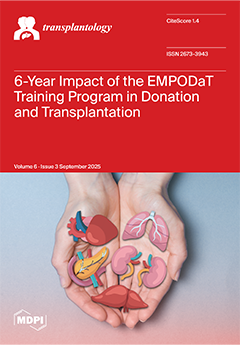Background/Objectives: This study aims to analyze the short- and medium-term outcomes of lung transplantation (LT) in recipients aged 65 years and older, comparing them with those of younger individuals. The primary endpoints were 90-day and 1-year survival, while secondary measures included perioperative complications and chronic lung allograft dysfunction (CLAD) rates.
Methods: A retrospective cohort analysis was conducted on 135 patients who underwent LT at the Siena Lung Transplant Center between January 2013 and December 2023. The participants were stratified into three age groups: under 60 years (Group Y), 60–65 years (Group M), and over 65 years (Group O). Outcomes assessed included ischemia times, transplant type (single or bilateral), ICU and hospital stay, postoperative complications, and CLAD incidence. The data were analyzed using non-parametric statistics, Kaplan–Meier survival curves, and correlation tests between clinical variables and survival outcomes.
Results: Among the patients, 88 belonged to Group Y, 36 to Group M, and 11 to Group O. Idiopathic pulmonary fibrosis (IPF) was prevalent in older recipients (82%). Patients over 65 showed a lower prevalence of diabetes (
p = 0.025) and pulmonary hypertension (
p < 0.01). Bilateral LT was most common in Group Y (91%) and least in Group O (36%,
p < 0.0001). Group Y had the longest maximum ischemia time (425 ± 161 min vs. 315 ± 140 min in Group O,
p = 0.048). ICU stay (
p = 0.289) and hospital stay (
p = 0.900) did not differ significantly across groups. No group differences were observed in rates of primary graft dysfunction (
p = 0.869), need for renal replacement therapy (
p = 0.358), or prolonged ventilation (
p = 0.609). CLAD incidence was comparable (
p = 0.400), as were 90-day (
p = 0.997) and 1-year survival rates (
p = 0.174).
Conclusions: Carefully selected patients over 65 years old can achieve similar short- and medium-term outcomes to younger LT recipients. These findings support the inclusion of older candidates in transplant programs, while highlighting the need for further research to optimize perioperative strategies and long-term management in this age group.
Full article




